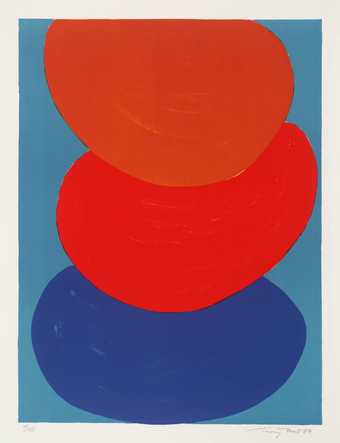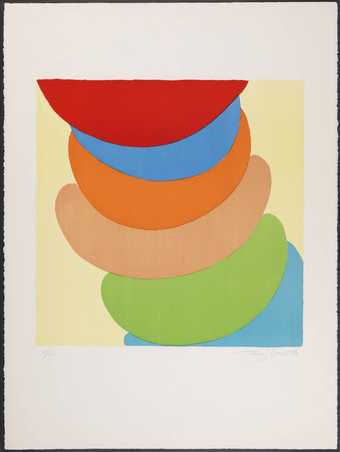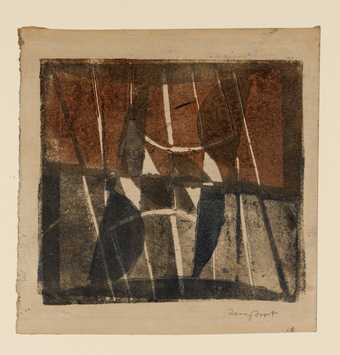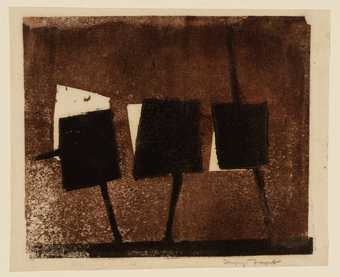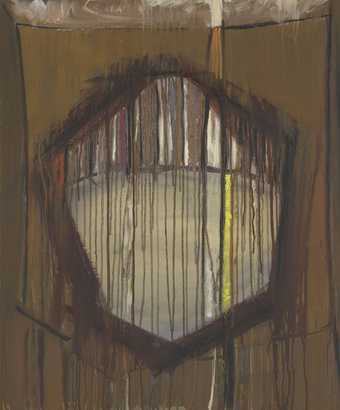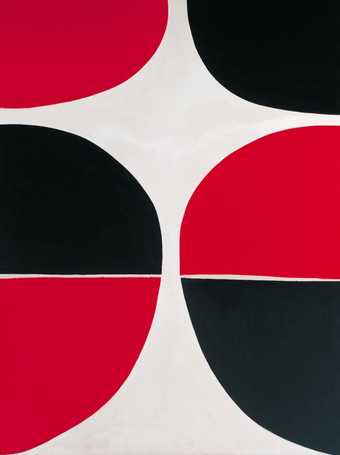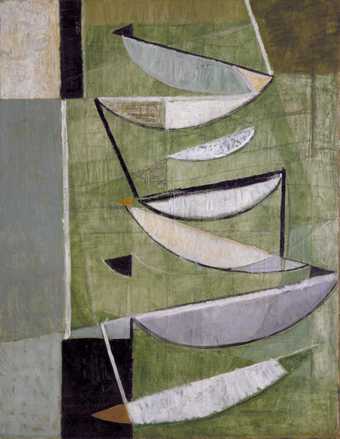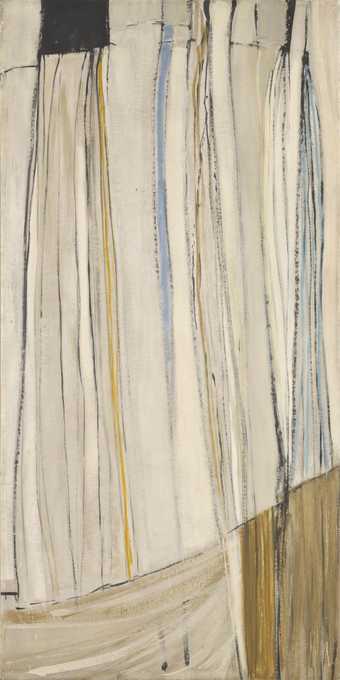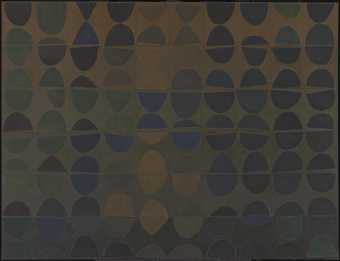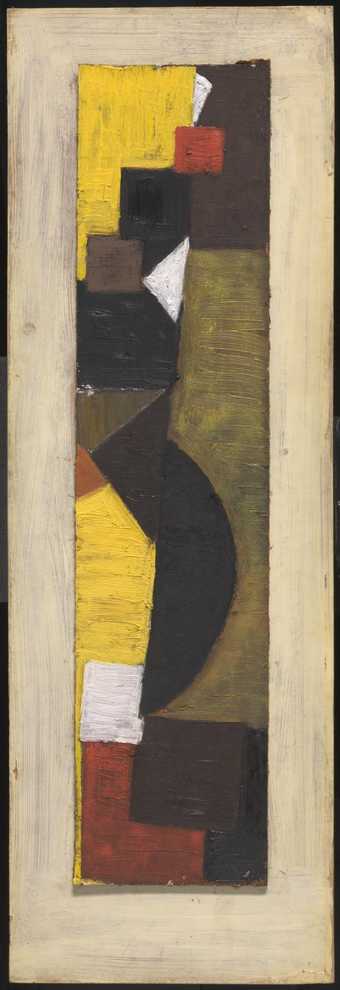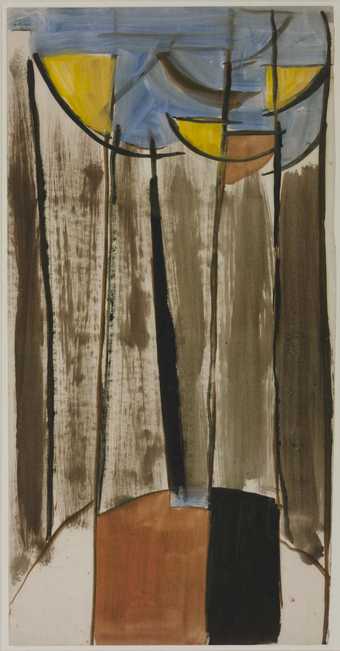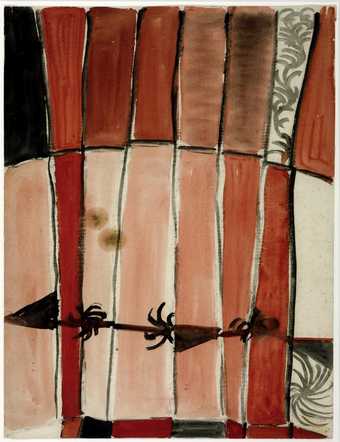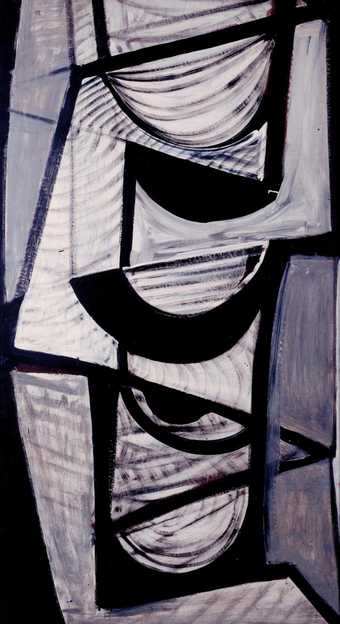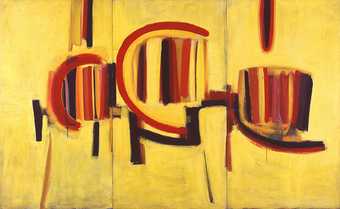
Not on display
- Artist
- Sir Terry Frost 1915–2003
- Medium
- Oil paint and canvas on canvas
- Dimensions
- Support: 1829 × 1833 mm
- Collection
- Tate
- Acquisition
- Presented by the artist 1992
- Reference
- T06603
Display caption
This is one of a series of laced works, some, as here, where the laces have been drawn by the artist, some using actual laces, threaded through the surface of the canvas. The theme was inspired by Frost seeing his wife sitting in a laced up bikini. He has said that this painting also refers to his grandmother's old fashioned stays or corsets that he frequently helped to lace up as a child. The artist has drawn in a spine above the laced section, indicating human anatomy. He has said of these laced works that the lacing was also a device to tighten the forms in the painting, 'I remember thinking I would like to use a spanner'.
Gallery label, September 2004
Does this text contain inaccurate information or language that you feel we should improve or change? We would like to hear from you.
Catalogue entry
Terry Frost born 1915
May 1962 (Stays)
1962
T06603
Oil and collaged canvas on canvas 1829 x 1833 (72 x 72 3/16)
Inscribed on back of canvas in black oil paint ‘Linen Back’, ‘Stays’, ‘May 62 | Terry Frost’ and ‘Frost’ top right and on top member of stretcher ‘<5558> STAYS’
Presented by the artist 1992
Exhibited:
Terry Frost, Bertha Schaeffer Gallery, October-November 1962 (8, as Stays)
Literature:
L.C. ‘Reviews and Previews: Terry Frost’, Art News, vol.61, no.8, December 1962, p.56
S.T. ‘In the Galleries: Terry Frost’, Arts, vol.37, no.3, December 1962, p.51
Reproduced:
David Lewis, Terry Frost, Aldershot 1994, p.77
This work exemplifies the ambiguity of the forms and content of much of Terry Frost’s output. The two quarter circles of canvas, glued on to the support, can be seen to allude both to boat forms and the human body. A later development from the work, which includes actual lacing in place of the crossed charcoal lines, bears the letters ‘SS9’, relating it to a boat (SS is the code that shows a boat to be registered at the port of St Ives in Cornwall). The erased section of the inscription on the stretcher of May 1962 (Stays) may refer to this other work, having been made, perhaps, in error. Boats, signified by semi-circles, quarter-circles or shallow arcs, have been a staple of Frost’s visual vocabulary since c.1950.
In contrast, the subtitle of the present work - (Stays)
- invokes the idea of a corset laced at the back. In 1993, the artist recalled the origin of the image:
I made a drawing [1955] of Kath [Frost] from behind as she was sitting ... and there were these two semicircles of her buttocks coming in from the side of the paper with the criss-cross of the lacing of her bathing suit, tied in a bow, in black charcoal – and that simple drawing had a lot of meaning for me. I remember as a kid I used to have to lace up my grand-mother in the ivory-coloured stays, and how she had a bit of red flannel where her cleavage was. And I remembered how Ben [Nicholson] used to talk about ‘tightening up the form’ as though he was talking about a spanner. And then when I looked at these semi-circular shapes in my drawing my mind went back to the boats, and I thought about how the brown mizzen sails at the stern are laced taut to keep the boat into the wind.[1]
In 1998 Frost stressed the formal aspect of the composition, the ‘lacing’ being a device to tighten the composition. He took this literally and in SS9, 1962-3, (private collection)[2]
he used actual laces, threaded through holes in the support, to draw the canvas together. This method was not very successful and in subsequent works he made proper holes with grummets and slit the canvas to prevent it from rucking up as it was drawn together.[3]
The creation of formal tension through the inter-relationship of two masses would become an important aspect of Frost’s work, seen in such works as June, Red and Black 1965 (Tate T00829). It was a concern which he shared with, and perhaps adopted from, such close friends as Roger Hilton and William Scott. Scott in particular employed similar curvaceous forms and played on the formal ambiguity between landscape, bodies and still life objects in a way comparable to Frost’s work.
Despite Frost’s insistence on its formal aspect, he continued to recognise the erotic figuration underlying May 1962 (Stays) and confirmed that the two quadrants could be read as breasts or buttocks.[4]
The cluster of straight lines towards the top left-hand side, he explained, was ‘a figurative touch’, a reference to armpit hair.[5] On another occasion, he identified the pattern of vertical marks up the middle as the spine of the figure.[6]
Sources for the red and black forms at the top have not been identified; as a simple, formal device, the combination of red, black and white has been a recurring feature in Frost’s work, which the artist attributes to the influence of the Russian Constructivists. He was not alone in his move from abstraction towards an erotic figuration. Close colleagues had revealed similar concerns: Peter Lanyon, generally thought of as an abstract landscape painter, produced a number of works based on the female nude or on sexual couplings. Similarly, the body had been an element in most of the work of Roger Hilton, who was particularly close to Frost; and became even more overt from 1961, as is demonstrated by such works as Figure, February, 1962, (Tate T01183) and Oi Yoi Yoi, 1963, (Tate T01855). This renewed attention to an open, joyous, erotic body may be seen in relation to the use of such motifs by figurative artists, in particular those associated with Pop, and the growing liberalisation of sexual codes of behaviour, a process registered in such events as the 1960 trial of D.H. Lawrence’s Lady Chatterley’s Lover.
Stays
is one of several works of this period which signalled Frost’s return to collage. Following his teacher Victor Pasmore, he had used collage in the late 1940s and early 1950s. From the early 1960s, it would remain a major aspect of his working practice. The attachment of canvas to canvas helped to emphasise the flatness and integrity of the picture plane, a major issue for Frost as for many of his contemporaries. It also shows an interest in the materiality of the work of art, another key aspect of late modernist aesthetics. The early 1960s witnessed a revival of collage and of assemblage that was marked in 1961 by a survey at the Museum of Modern Art, New York, of the Art of Assemblage. However, much recent work, such as that of Robert Rauschenberg, incorporated found objects – often urban or domestic detritus – in contrast to Frost’s simple use of artist’s canvas.
In Stays, two large quadrants of unprimed canvas have been stuck onto a canvas support, which was probably commercially prepared with an off-white oil ground to which the artist added a second layer. Frost has identified the adhesive as rabbit skin glue, which has a tendency to ‘brittle up’.[7]
In places this extends beyond the area of the collage, and onto its upper surface, and these residual smears have contracted, causing the paint underneath to crack, cup and pull away from the ground. The two shapes were drawn in charcoal before being cut out. In 1993, the artist declared the picture in good condition and welcomed the staining to the collage as ‘part of the painting ... when the boats sail in the wind they always get lovely stains from the seagulls, that is really very much of the St Ives period’.[8]
The order in which the work was made is not clear. White paint may extend under the two attached canvases. While some charcoal drawing underlies the paint, the criss-cross lines at the centre, and the shallow concave line towards the bottom, were clearly added later; the clusters of black lines near the top corners are oil paint. The red and black oblongs at the top were painted over the white and pink and small dribbles of red on the left-hand collage suggests that the stronger colour was added at a late stage. Drips on the canvas turn-over show that the picture was painted in both a vertical and horizontal position. Two sets of tack holes suggest that, at some point, the canvas may have been re-stretched. The fact that the stretcher seems to be of Sugar Pine, a material used in the United States, supports Frost’s speculation that this change may have been made while the picture was in America; he recalled it having a distressed silver frame from New York.
Stays
clearly stood out when first shown, in New York, as it was singled out in two reviews. The anonymous reviewer in Art News found it one of the few good works on show. Frost’s images, he wrote, ‘tend to be circular or at least curvilinear, are rough, informal, simple, dull and large. If it weren’t for this largeness one might like them better. ... One remembers distinctly only those [paintings] with obvious symbolist significance, for instance the one with the collage of unpainted canvas called Stays.’[9]
The author of a review in Arts
was more positive about the exhibition as a whole and focussed on Frost’s development of his medium:
These new paintings by a British abstract painter have considerably more vigor than those in his last show. Frost seems to have caught the hang of paint as a complement of his signs and there is less distance between idea and presentation. ... The search for substance has led Frost to glue cut-out linen shapes on the surface in one work (Stays), and thus publicizes a corresponding effort to suggest an image without being specific about it.[10]
On acquisition, a label recovered from the back of the frame revealed that it had been at Waddington Galleries, London, at some point. It has not been found in any exhibition catalogue.
Chris Stephens
December 2000
[5] Ibid.
[6] Interview with Tate Gallery conservators, 17 February 1993
Explore
- abstraction(8,615)
-
- from recognisable sources(3,634)
-
- man-made(999)
- non-representational(6,161)
-
- irregular forms(2,007)
- clothing and personal items(5,879)
-
- corset(2)
You might like
-
Sir Terry Frost Ochre, Red, Blue
1969 -
Sir Terry Frost Red, Blue, Orange on Yellow
1969 -
Sir Terry Frost Boat Shapes
1952 -
Sir Terry Frost Boat Shapes
c.1954 -
Sir Terry Frost Boat Shapes
1954 -
Sir Terry Frost Khaki and Lemon
1956 -
Sir Terry Frost June, Red and Black
1965 -
Sir Terry Frost Green, Black and White Movement
1951 -
Sir Terry Frost Winter 1956, Yorkshire
1956 -
Sir Terry Frost Through Blacks
1969 -
Sir Terry Frost Brown and Yellow
c.1951–2 -
Sir Terry Frost Untitled Composition
c.1955 -
Sir Terry Frost Untitled Composition
1954–6 -
Sir Terry Frost Black and White Movement
1952 -
Sir Terry Frost Yellow Triptych
1957–9

